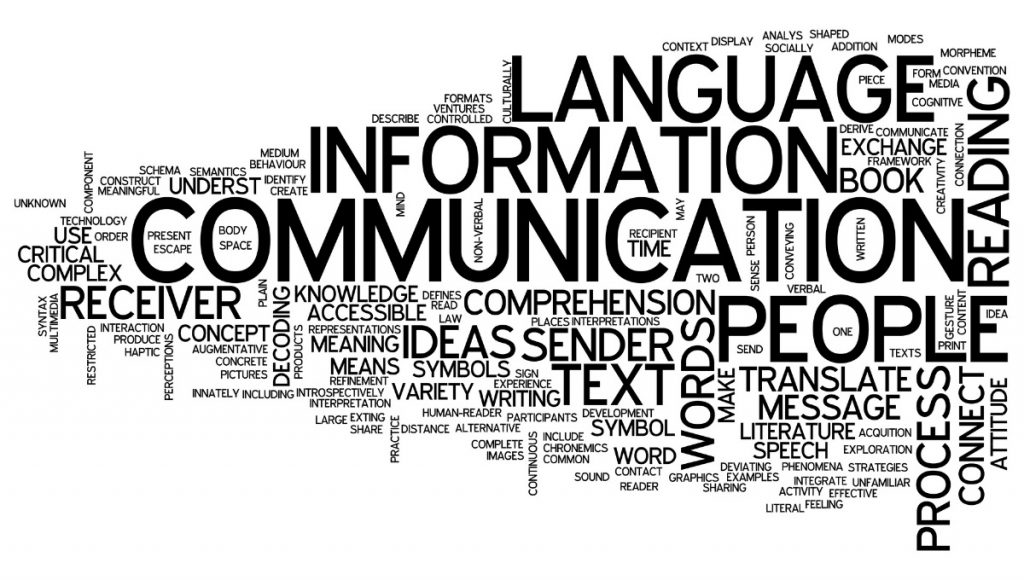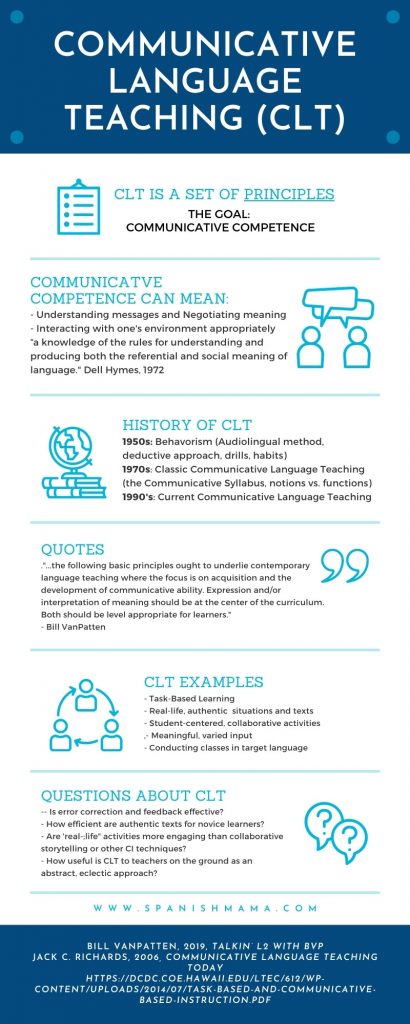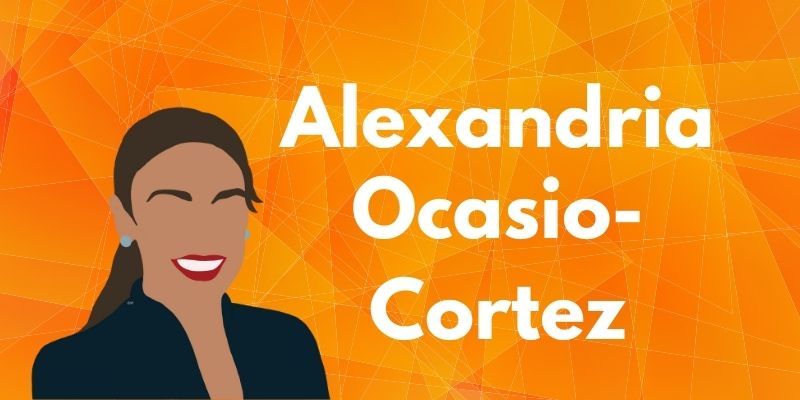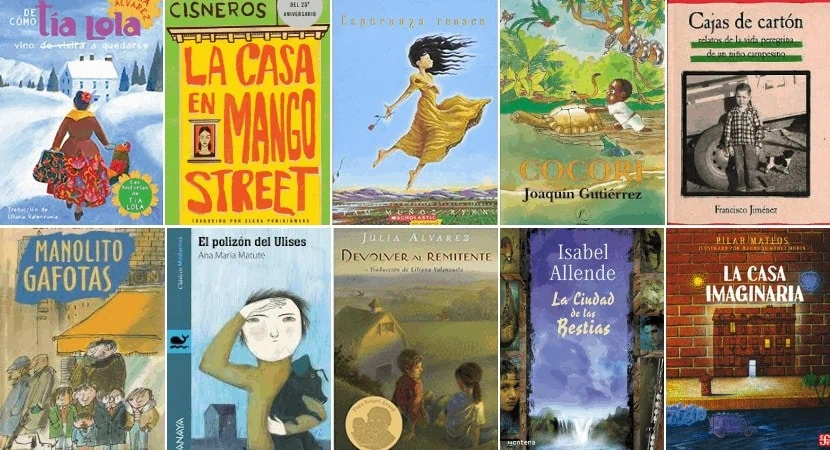What is Communicative Language Teaching (CLT)?
Inside: An overview of CLT (communicative language teaching), its history, and examples of techniques and activities.
“Communicative language teaching” has been a buzzword among language teachers and researchers for a while now, and a popular way of describing language approaches since the 1990s.
However, if you spend a little time Googling “what is the definition of communicative teaching?,” you might walk away more confused than when you started. Is CLT a method? A technique? Is there one definition or authority on it?
Here’s the thing: CLT is a set of principles. And they’re not all exactly agreed upon by researchers.
At a minimum, most writers agree on these basics:
- Communicative competence is the goal.
- Learners use appropriate strategies to negotiate meaning and understand messages.
- Learners interact through collaboration and real-life tasks.

Related: What is Comprehensible Input?
Let’s dive in further see what the have to experts say, and what CLT means for our classrooms in the 21st century.
Here’s an outline of the information in this post:
- The History of CLT
- What Communicative Language Teaching Isn’t
- What Communicative Language Teaching Is, Broadly
- Examples of CLT and CLT-Based Activities
- Pros and Cons of CLT
- Getting Deeper into the Research About CLT
The History of CLT
The term “communicative language teaching” first came into prominence in the 1970s. The principles behind it appear throughout history, however (I’m thinking of Johann Comenius in the 17th century or François Gouin in the 19th century).
During most of the 20th century, direct or grammar-translation methods dominated language teaching. The Audiolingual method, popularized in the 1950s, applied Skinner’s ideas of behaviorism the language classroom and relied heavily on drills and practiced dialogues.
Language mastery is represented as acquiring a set of appropriate language stimulus-response chains. Foreign language learning is basically considered as a process of mechanical habit formation. The focus is on the mastery of phonological and grammatical structures and the sequence is assumed to start with phonological level and end up with sentence level.
– Gholamabbass Shaheidari, The Audiolingual Method (1997)
The focus of language teaching was accuracy, and giving students the building blocks of language (grammar rules and vocabulary). The teacher was at the center, providing explanations and example dialogues. Students would build up language “habits” that led to accurate communication.
Noam Chomsky, known as the “father of linguistics,” argued that language acquisition is a more complex and unconscious process than previously believed.
According to John Phillips and Chrissie Tan,
“Chomsky is concerned to establish a science that would study what he calls “the language faculty”, in analogy with other mental faculties like logic, which as a kind of intuitive reasoning power requires no accumulation of facts or skills in order to develop. Grammatical knowledge too seems to be present and fully functional in speakers fluent in any language. So competence in Chomsky’s sense implies neither an accumulated store of knowledge nor an ability or skill. He rejects Saussure’s langue as “merely a systematic inventory of items”, and instead returns to a rationalist model of underlying competence regarded as “a system of generative processes.”
– The Literary Encyclopedia
In the 1970s, certain researchers began to shift the priority from grammatical competence to communicative competence. That is, the ability to understand and produce meaningful language, instead of just knowing about language.
“What people want to do through language is more important than mastery of language as an unapplied system.”
– D.A. Wilkins 1972, A syllabus for communicative competence

Linguist Dell Hymes came up with the term communicative competence in 1972 as “a knowledge of the rules for understanding and producing both the referential and social meaning of language.”
From there, and as the global landscape changed, the focus gradually shifted to what students could do with language.
For textbook creators and leaders creating curriculum and syllabi, this led to a distinction between notion and function, beyond
- Notions: categories of ideas like spatial ideas (location, adverbs, position), quantitative (numbers, quantity), etc.
- A function: an act of communication such as greeting, making a requests, reporting, etc.
What Communicative Language Teaching is Not
Before diving into a specific description of a “Communicative Language Teaching Approach,” it might be most helpful to describe what CLT is not.
Here are some points of what it’s not:
- CLT is not grammar-translation. This is obvious from the history above, but just to reiterate: the focus is communicating messages, not building out-of-context knowledge.
- CLT is a not method, precisely. According to Bill VanPatten, a more helpful framework is to look at CLT as a set of guiding principles. There are many methods that fit into the framework.
- CLT means students are always speaking. I see this one a lot, and use of the word “communicative” is probably to blame here. If we think of communication as any meaningful message, we can see that it can include many kinds of interaction, including learners with text.
- CLT implies that students learn (= acquire language) by speaking. While students may benefit from speaking, CLT doesn’t mean pairing up students to practice dialogues until it becomes internalized (that’s harking back to the 50s). Whenever students are speaking, it should always be using language they are ready for.
For more information on this, you can listen to Episode 31 of Tea with BVP to hear his discussion on how Communicative Language Teaching is misunderstood.

So, What’s A Good Definition of CLT?
As mentioned before, CLT is a set of principles, or a theory– not a method, and without a single author or authority. This, however, is a stab at the core idea:
The goal of communicative language teaching is communicative competence, through authentic (or real-life) communication.
Here’s how the Merriam-Webster dictionary defines communication:
1a: a process by which information is exchanged between individuals through a common system of symbols, signs, or behavior
also: exchange of information
b: personal rapport, a lack of communication between old and young persons
2a: information communicated : information transmitted or conveyed
b: a verbal or written messageThe captain received an important communication.
And by authentic we mean to say meaningful interaction: related to real-life, authentic resources, student-centered topics, or open-ended discussions in the target language.
In this context, the target language is the vehicle for meaningful messages, not just something practiced for the sake of being practiced.
And teachers are most effective when they design authentic tasks and provide relevant input for their students.
If we want a more robust definition, Jack Richards outlines four core principles in Communicative Language Teaching Today.
David Nunan’s (1991) five features of Communicative Language Teaching vary slightly from Richards. They are:
1. an emphasis on learning to communicate through interaction in the
– The Public Administration and Social Policies Review IV Year, No. 1(8) / June 2012, 95
target language,
2. the introduction of authentic texts into the learning situation,
3. the provision of opportunities for learners to focus, not only on
language but also on the learning management process,
4. an enhancement of the learner’s own personal experiences as
important contributing elements to classroom learning
5. an attempt to link classroom language learning with language activities outside the classroom
CLT Examples and Activities
It always helps to have some concrete examples to flesh out what approaches look like in real life, right? Here are some practical techniques to help us bring theory into the everyday language classroom.
Task-Based Learning
Tasks, as defined in video below by Musicuentos are:
1. Meaning is central to the task
– Sara-Elizabeth Cottrell
2. There’s a communicative goal
3. The activity is measure by the outcome
4. Focus is on the forms as needed
5. There’s a real-world relationship
This is an excellent video that outlines the basics of Task-Based Language Teaching:
Special Person Interviews
I think Special Person Interviews are a great example of CLT. They are essentially a series of interviews that the teacher does with individual students, in front of the whole class. The idea is to find out more about that student and get to know them, while staying in the target language and keeping it comprehensible. This follows the idea of centering your lesson plans on your students, making them your curriculum. (Read about about Special Person Interviews here.)
With Special Person interviews, the lesson is not “let’s practice saying what we like and describe ourselves.” The goal (= task) is that students will genuinely learn more about each other and develop a strong community. Assessments reflect this too. In the process, of course, students are interacting with all kinds of messages to convey personal information, likes and dislikes, hobbies, schedule, etc.
And yet the goal is not memorizing that vocabulary, even though though students will acquire it.
Class Surveys
Another example is class surveys. This is something I do even with my preschool classes! If we are talking about animals, there are lots of ways to simply practice the vocabulary.
However, in order to create a task with authentic communication, we could do a class poll seeing which are most common among the students, or which pets are the most popular. This is a real-life sort of question kids are already interested in, and their experiences and opinions are centered in the activity.
TPRS
Teaching Proficiency through Reading and Storytelling, or TPRS may not seem at first glance to fit the CLT framework– if, like some, we make the mistake of thinking of CLT as paired speaking activities. (Read more about TPRS here.) TPRS is:
- A collaborative interaction between the teachers and students.
- It’s an open-ended story format is guided by student interests.
- The goal is create an entertaining or interesting plot, and language is the vehicle used for creation.
Pros and Cons of Communicative Language Teaching
These are simply my personal opinions on the benefits and shortcomings of CLT.
Pros:
- Meaningful messages are at the heart of CLT. This, to me, lines up with Second Language Acquisition (SLA) research.
- Lesson are student-centered. By making student interest central to lessons, student buy-in is higher.
- Communicative competence is valued over grammatical competence.
Cons:
- CLT as a theory may not be concrete enough to affect everyday teachers in the classrooms. By being so broad, it may be one of those things everyone claims and therefore loses any real meaning.
- By emphasizing “tasks” (which is actually a very broad term), CLT might unnecessarily cause teachers to overthink their lessons. I wish more CLT literature would use the term “high-frequency” language over realistic or real life.
What Do CI and CLT Have to Do With Each Other?
This is the burning question for me. Is CLT another way of describing comprehensible input? Are they at odds with one another?
Comprehensible input regularly gets mislabeled as a method. It’s not. It’s a thing (messages that are understood).
Communicative language teaching, on the other hand gets mislabeled as a thing instead of as a set of principles.
So it’s not really one or the other.
I believe that comprehensible input is *the* ingredient for language acquisition. Learning about comprehensible input is far more practical to me, as a teacher. It directly dictates the exact content I create or select for my lessons.
CLT is a useful framework, however, for describing the goal of my classes. I want students with communicative competence, yes, who spend our classes negotiating meaning in the target language — and who feel that our lessons are relevant and interesting to their lives.
Especially when working with older learners,
“They have a right to expect language courses, like medical treatments, to be relevant and, ideally, to be designed just for them or, at the very least, for learners like them. That is why, to be rational, relevant, and successful, language course development should begin with an identification of learners’ goals and an analysis of their present or future communicative needs to achieve those goals.”
– Mike Long, Second Language Acquisition and Task-Based Language Teaching
Conclusion
As CLT theory continues to develop, I’ll continue to interact with it through my “comprehensible input eyes.” For example, authentic texts are touted as excellent, even vital tools for CLT. While I do love authentic resources (and students often do as well), I don’t consider them to be superior to class-created or teacher-created texts.
If we have a comprehensible story that’s highly interesting to the students, for instance, I’d rather use it than wrangle an authentic text to meet our needs. Because I’m interested students who can navigate the real world, I’m also interested in what most efficiently helps my students acquire language they can use.
I would love to hear your thoughts in the comments below!








it was really useful.